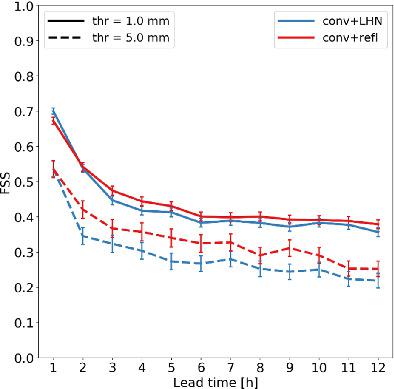当前位置:
X-MOL 学术
›
Q. J. R. Meteorol. Soc.
›
论文详情
Our official English website, www.x-mol.net, welcomes your feedback! (Note: you will need to create a separate account there.)
Assimilation of radar reflectivity volumes in a pre‐operational framework
Quarterly Journal of the Royal Meteorological Society ( IF 8.9 ) Pub Date : 2020-12-16 , DOI: 10.1002/qj.3957 Thomas Gastaldo 1 , Virginia Poli 1 , Chiara Marsigli 1, 2 , Davide Cesari 1 , Pier Paolo Alberoni 1 , Tiziana Paccagnella 1
Quarterly Journal of the Royal Meteorological Society ( IF 8.9 ) Pub Date : 2020-12-16 , DOI: 10.1002/qj.3957 Thomas Gastaldo 1 , Virginia Poli 1 , Chiara Marsigli 1, 2 , Davide Cesari 1 , Pier Paolo Alberoni 1 , Tiziana Paccagnella 1
Affiliation

|
The assimilation of radar reflectivity data is of great interest for numerical weather prediction (NWP) models at the convective scale since these observations are very dense both in space and time and they are related to microphysical prognostic variables. So far, the assimilation of reflectivity in operational frameworks has been limited to derived products, like precipitation rates and humidity profiles. This approach is also adopted at ARPAE‐SIMC, the Hydro‐Meteo‐Climate Structure of the Regional Agency for Prevention, Environment and Energy of Emilia‐Romagna region in Italy, where latent heat nudging (LHN) is employed to assimilate precipitation rates in the COSMO‐2I model, the convection‐permitting version of the regional model developed by the COnsortium for Small‐scale MOdelling (COSMO) which is run operationally to provide high‐resolution forecasts over Italy. However, to fully exploit the information contained in these observations, the whole reflectivity volume should be directly assimilated. Nevertheless, despite several promising studies, its implementation in an operational framework has not yet been achieved. In this study, a set‐up designed to assimilate reflectivities operationally in the COSMO‐2I model through a local ensemble transform Kalman filter (LETKF) has been evaluated over 37 days in 2018 and performed 303 forecasts. The comparison with the current operational set‐up based on LHN reveals an average improvement in quantitative precipitation forecasts (QPFs) up to 7 hr, even if the impact on convective cases is much stronger than that observed in conditions of stratiform precipitation. Moreover, a small but positive impact is noticed for the RMSE of upper‐air variables, while the impact on bias is mixed. Mixed results are also obtained when considering surface variables. In the light of the results of this study, a pre‐operational parallel system in which COSMO‐2I analyses are generated replacing LHN by the direct assimilation of reflectivity volumes was implemented in April 2020.
中文翻译:

在运行前框架中对雷达反射率体积的吸收
雷达反射率数据的同化对于对流尺度的数值天气预报(NWP)模型非常重要,因为这些观测在空间和时间上都非常密集,并且与微物理预后变量相关。到目前为止,在操作框架中对反射率的吸收仅限于派生产品,例如降水率和湿度曲线。这种方法在ARPAE‐SIMC(意大利艾米利亚—罗马涅地区预防,环境和能源区域机构的水文气象结构)中也采用了该方法,在该方法中,采用潜热微动(LHN)吸收了该地区的降水率。 COSMO-2I模型,由小规模建模联盟(COSMO)开发的区域模型的对流允许版本,该模型正在运行中以提供意大利的高分辨率预报。但是,要充分利用这些观测值中包含的信息,应直接吸收整个反射率体积。然而,尽管进行了一些有希望的研究,但尚未在业务框架中实施。在本研究中,旨在通过本地集成变换卡尔曼滤波器(LETKF)在COSMO-2I模型中有效吸收反射率的设置已在2018年评估了37天,并进行了303次预测。与基于LHN的当前运营设置进行的比较显示,长达7小时的定量降水预测(QPF)有了平均改善,即使对流情况的影响要比层状降水条件下的影响要大得多。此外,对高空变量的RMSE产生了很小但积极的影响,而对偏差的影响则是好坏参半。当考虑表面变量时,也会获得混合结果。根据这项研究的结果,于2020年4月实施了一个运行前的并行系统,在该系统中生成了COSMO-2I分析来代替LHN,并直接吸收了反射率体积。
更新日期:2020-12-16
中文翻译:

在运行前框架中对雷达反射率体积的吸收
雷达反射率数据的同化对于对流尺度的数值天气预报(NWP)模型非常重要,因为这些观测在空间和时间上都非常密集,并且与微物理预后变量相关。到目前为止,在操作框架中对反射率的吸收仅限于派生产品,例如降水率和湿度曲线。这种方法在ARPAE‐SIMC(意大利艾米利亚—罗马涅地区预防,环境和能源区域机构的水文气象结构)中也采用了该方法,在该方法中,采用潜热微动(LHN)吸收了该地区的降水率。 COSMO-2I模型,由小规模建模联盟(COSMO)开发的区域模型的对流允许版本,该模型正在运行中以提供意大利的高分辨率预报。但是,要充分利用这些观测值中包含的信息,应直接吸收整个反射率体积。然而,尽管进行了一些有希望的研究,但尚未在业务框架中实施。在本研究中,旨在通过本地集成变换卡尔曼滤波器(LETKF)在COSMO-2I模型中有效吸收反射率的设置已在2018年评估了37天,并进行了303次预测。与基于LHN的当前运营设置进行的比较显示,长达7小时的定量降水预测(QPF)有了平均改善,即使对流情况的影响要比层状降水条件下的影响要大得多。此外,对高空变量的RMSE产生了很小但积极的影响,而对偏差的影响则是好坏参半。当考虑表面变量时,也会获得混合结果。根据这项研究的结果,于2020年4月实施了一个运行前的并行系统,在该系统中生成了COSMO-2I分析来代替LHN,并直接吸收了反射率体积。



























 京公网安备 11010802027423号
京公网安备 11010802027423号